Interior of Oradour-sur-Glane
Church
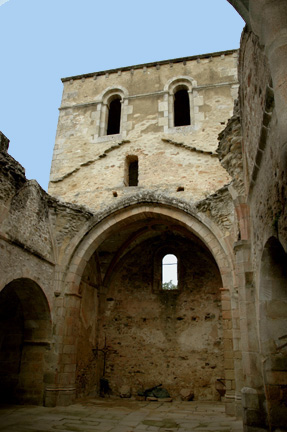
The photo above shows the inside of the
church with the back wall of the tower in the center under the
arch. According to an exhibit in the Center of Memory, "the
upper rafters and the bell tower of the church were destroyed
by fire but the arches above the nave were left." The roof
over the nave collapsed after the fire and the main part of the
church is now open to the sky. The front door into the church
is on the right, but out of camera range. Above the arch in the
center of the photo, you can see the outline of where the roof
of the nave (the main part of the church) was attached to the
tower.
The bronze church bells, which melted
from the heat of the fire, are shown on the floor in the center
of the photo above. According to a book entitled "Martyred
Village," written by Sarah Farmer, this is the spot where
the bells landed when they fell from the tower. However, the
ceiling under the arch appears to be intact, as the photo below
shows.
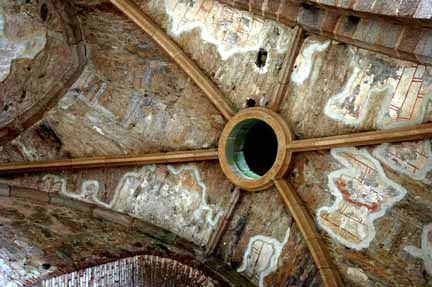
The photo above shows the ceiling above
the melted bells. I did not see any way to enter the tower from
inside the church. In the SS version of the story, the claim
is made that a bomb had been stored inside the tower by people
living in the village, who were allegedly supplying weapons to
the French resistance, and when the bomb was detonated, this
caused the bells to melt. However, there is very little damage
that can be seen inside the church today and no damage to the
tower, except that the steeple is gone.
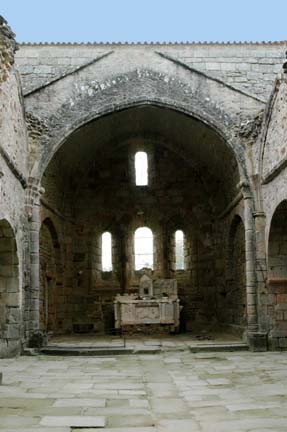
The photo above shows the front of the
church and the main altar. I was amazed by how small the church
is on the inside. The roof is gone, but you can still see where
it was attached to the wall. Madame Marguerite Rouffanche, the
lone survivor of the church, escaped through the middle window
above the altar, which is about 9 feet from the stone floor.
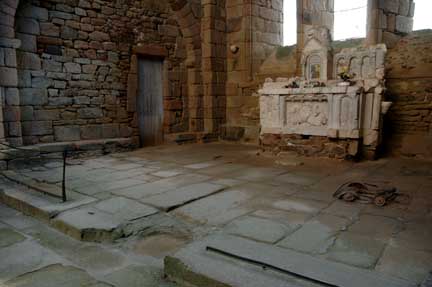
The photo above shows a view of the main
altar with the door to the vestry, also called the sacistry,
on the left side. This door was broken down by the women and
a number of them, including Madame Rouffanche and her daughter,
went through this door into the sacistry. Madame Rouffanche's
daughter was killed by shots fired from outside the sacistry.
Madame Rouffance survived by pretending to be dead; then she
went back inside the church and made her escape through a window
above the altar.
In the foreground of the photo above
is what is left of the communion rail. In the center is a hole
in the stone floor which might have been made by a grenade thrown
into the church.
On the right side of the photo above
is the rusted remains of a pram, or baby carriage. The pram seems
to have disintegrated almost into dust. A close-up of it is shown
in the photo below.
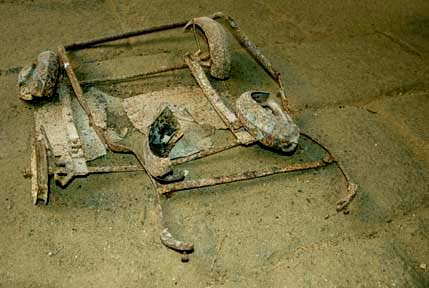
The Official Publication of the survivors
quotes Madame Rouffanche as saying that a smoke bomb was placed
near the choir which is no longer there, but it would have been
in the back of the church. A circular stone staircase in the
back of the church on the right side as you face the altar was
probably the access to the choir loft, which is typically in
the rear of a Catholic church.
Other books, such as "Oradour Village
of the Dead," by Philip Beck quote Madame Rouffanche as
saying that the bomb was placed near the communion railing. However,
Madame Rouffance also said that after the "smoke bomb"
went off, the women and children rushed to the part of the church
where they could still breathe, which she said was the front
of the church. They broke down the sacistry door in an attempt
to escape from the smoke.
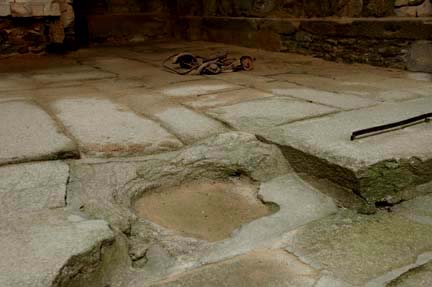
The photo above shows a closeup of the
hole in the stone floor in the center of the communion railing.
In the background, on the right, you can see the pram, or baby
carriage, which is badly disintegrated. On the far right is what
is left of the metal communion rail. This appears to be the spot
where a bomb was placed or a grenade hit the floor. Other than
this spot, the stone floor of the church is undamaged.
|